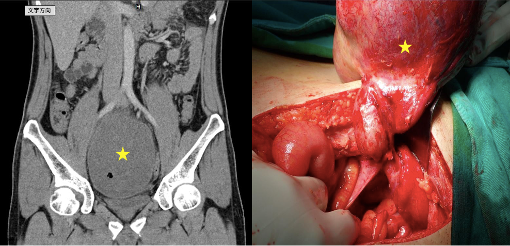源自隱睪的巨大精原細胞癌偽裝畸胎瘤:病例報告
鄭鼎耀1、陳建志1, 2
1台北馬偕紀念醫院泌尿科;2馬偕學校財團法人馬偕醫學院
A Huge Seminoma of An Undescended Testis Mimicking Teratoma: A Case Report
Ting-Yao Cheng1, Marcelo Chen1,2
Department of Urology, MacKay Memorial Hospital, Taipei, Taiwan1; School of Medicine, MacKay Medical College, New Taipei City, Taiwan2
Case Presentation: A 42-year-old male was referred to our emergency department from another hospital with persistent left lower quadrant (LLQ) pain for two days, along with diarrhea, vomiting, and poor appetite. The patient had been diagnosed with an abdominal tumor at the referring hospital by computed tomography (CT) image. He denied any significant past medical history. Laboratory tests on admission showed an elevated C-reactive protein (CRP) level of 23 mg/dL, a hemoglobin (Hb) level of 13.1 g/dL, and a white blood cell (WBC) count of 18,500/uL. His liver function tests were mildly elevated with an alanine aminotransferase (ALT) level of 42 IU/L and a lactate dehydrogenase (LDH) level of 503 IU/L. Abdominal ultrasound revealed a 13 cm lobulated mass with hyperechoic reflectors over the lower abdominal area. Abdominal CT reported a 14 cm lobulated mass with fat contents and tiny calcification at pelvic region, raising the suspicious of a teratoma. No grossly enlarged lymph noted was found (Figure 1).
Flexible sigmoidoscopy was negative up to 60 cm from the anal verge, and tumor markers, including alpha-fetoprotein (AFP), carcinoembryonic antigen (CEA), carbohydrate antigen (CA) 199, and CA 125, were within normal limits except for the elevated CA 125 level of 215.5 U/mL. The patient underwent laparotomic tumor excision by a general surgeon, during which the tumor was found to be connected with the spermatic cord (Figure 1). A urologist was consulted and the absence of the left testis was noted. En bloc resection was performed. Surgical pathology reports revealed cryptorchidism and seminoma with torsion. Postoperative laboratory tests showed a beta-human chorionic gonadotropin (beta-hCG) level of <0.6 mlU/mL and an LDH level of 518 IU/L. The patient had a smooth recovery course. Further follow-up and treatment planning will involve multidisciplinary collaboration between oncology and urology teams.
Discussion/Conclusion: The presented case highlights the importance of considering all potential diagnoses and conducting a thorough physical examination in patients with abdominal masses. The patient in this case had been initially diagnosed with an abdominal tumor at the referring hospital, which led to further workup and surgery. However, during the laparotomy, the absence of the left testis was noted, which was indicative of cryptorchidism. Pathology reports further revealed the presence of seminoma with torsion, which could have been missed without a proper evaluation for cryptorchidism.
Cryptorchidism is a common congenital anomaly in which one or both testes fail to descend into the scrotum. It is a significant risk factor for testicular malignancy, with seminoma being the most common histological subtype. The incidence of testicular cancer is 3.7-7.5 times higher in men with cryptorchidism than in the general population. Moreover, the risk of seminoma development is directly proportional to the duration and location of cryptorchidism. In addition to malignancy, cryptorchidism can also lead to torsion, which can result in testicular infarction and further increase the risk of malignancy.
In the presented case, the initial diagnosis without considering the possibility of cryptorchidism led to cumbersome workup and delaying the surgery. This highlights the importance of a thorough physical examination, including a testicular exam, in patients with abdominal masses. Additionally, given the increased risk of malignancy in patients with cryptorchidism, prompt evaluation and management are essential. Testicular ultrasound should be considered in patients with suspected cryptorchidism, and surgical correction should be performed as soon as possible to decrease the risk of malignancy and torsion.
In conclusion, the presented case emphasizes the importance of considering cryptorchidism as a potential diagnosis in patients with abdominal masses, particularly in men with a history of undescended testes.
Figures 1.
